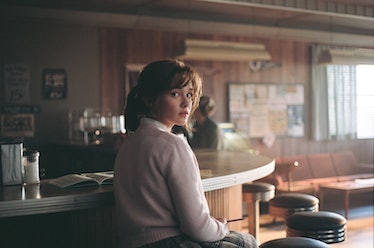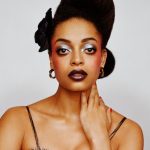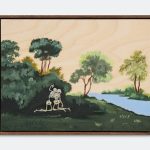Sofia Coppola is nothing if not meticulous in her attention to detail. In her films, a single hair out of place or smudged cat-eye is no accident, but rather very much part of a character’s development. Such is the case in Priscilla, the heartrending coming-of-age story adapted from Priscilla Presley’s 1985 memoir Elvis and Me. “Sofia told us she wanted the hair, makeup, and the costumes to help show the passage of time,” says Cliona Furey, who served as the film’s hair department lead. To that end, Furey styled and restyled just five wigs to depict Priscilla’s (played by Cailee Spaeny) evolution from a young teenager who first meets Elvis (Jacob Elordi) in 1959 to when she leaves him in 1979. The wardrobe department, on the other hand, had a lot more looks to work with. Costume designer Stacy Battat—who’s worked with Coppola on five of her eight films—commissioned over 120 looks including custom pieces from Anna Sui and Chanel, both longtime creative collaborators of Coppola’s. Here, a scene-by-scene breakdown of Priscilla’s style choices and what they mean, straight from the creatives who made the movie magic happen.
Just a Teenager
Cailee Spaeny as a 14-year-old Priscilla
Sabrina Lantos
Priscilla is a bored and lonely 14-year-old Army brat in Germany when a member of Elvis’s entourage spots her doing homework at her local soda shop and invites her to one of his boisterous house parties. For her first meeting with the singer, she wears a youthful pastel blue dress with bow detail. By their second encounter, she shifts to a more grown-up belted brown dress that could easily have been pulled from her mother’s closet. “She did really borrow stuff from her mom. There are photos of them in the same dress,” Battat says. “After Priscilla meets Elvis, I imagined that she started wearing her mother’s pumps instead of saddle shoes.” Her hair, too, becomes more polished transitioning from messy bangs and a loose ponytail into tidier fringe and smoothed-out curls and makeup designer Jo-Ann MacNeil introduced mascara, lipstick, and rouge to the previously makeup-free teen.
Priscilla says goodbye to Elvis at the airport in Frankfurt, Germany, after he completes his military service, in Priscilla (left) and real life (right)
Homecoming
After Elvis returns home to Memphis following his two year stint in the military, he flies the then 17-year-old Priscilla to Graceland for a reunion. She arrives at the grand estate in a rose-pink, empire waist dress with delicate floral embroidery and a ribbon belt. The look, custom-made by Anna Sui, featured a 1950s-appropriate crinoline for extra flounce.
Priscilla’s first trip to Graceland
Sabrina Lantos
Viva Las Vegas
When Elvis whisks the young Priscilla away for a dazzling weekend in Las Vegas, she experiments with a daring new look and hits the casino in a form-fitting ice-blue gown with an oversized bow atop one shoulder. “In my mind, Elvis always took her shopping in Vegas, like she came there with clothes her mother packed for her,” explains Battat, referring to an expository scene that was cut. As for her makeup, “We gave her an introduction to the cat eye—a subtler version—only on the top of her eye,” says Furey, who relied on Tom Ford Eye Defining Liquid Liner pen and Chanel palettes and lip colors for the entire 30-day shoot in Toronto. A “blue suede”-hued eye shadow delivered a defining, smokey effect, and nodded to The King’s 1956 hit from his debut album. Additionally, MacNeil marked a starting point for Priscilla’s upcoming drastic transformation with “heavy mascara,” but no false lashes.
“This makeup gave her a look into what her future possibly held—very different from her simple life in Germany—and she did like the attention it brought to her,” says MacNeil.
Priscilla with Elvis and the “Memphis Mafia” in Las Vegas
Sabrina Lantos
Priscilla and Elvis leaving a trip to Las Vegas
Bettmann/Bettmann/Getty Images
The Transformation Is Complete
Priscilla’s most radical change came at the behest of Elvis, now, in 1963, a box office and music chart-topping superstar. He convinces the still-17-year-old’s reluctant parents to allow her to complete high school in Memphis. “It’s such a sensitive story, because we look at it sometimes from the lens of today,” says Battat. “But through the lens of (that time), the aspirations for your daughter was to marry well.”
Priscilla doing her homework at Graceland while Elvis is away
Sabrina Lantos
Elvis begins dictating what Priscilla should wear, taking her shopping and expressing the colors and silhouettes he prefers to see on her. “I think these clothes are too sophisticated for me,” she says at one point. But Elvis is insistent on changing up Priscilla’s look, bringing her to the salon and saying, “Black hair and more eye makeup will make your eyes stand out more,” mirroring himself.
The camera pans for a slow close-up of Priscilla’s reveal, which still feels shocking despite all the familiar documentation of Presley’s ’60s style. “We penciled, arched and extended her eyebrows to match her now darker hair,” says MacNeil, replicating reference photos. “We evolved the cat eye into the lower lash line and extended the corners out further. We also started to add strip false eyelashes to really accentuate her eye makeup look and make her eyes pop.”
The focus on Priscilla’s overwhelming jet-black bouffant evokes a crushing sensation, like it’s figuratively engulfing her true self. But Furey slightly eased the jarring transition by softening the look with bangs. “She’s still young, but she’s getting glammy,” says Furey, who employed “very old school vintage methods” for ‘60s Priscilla: “setting” the wigs with large rollers that were heated in the oven, back-brushing and teasing and applying hairspray—though not as much as you’d think.
“I had to keep the wigs pliable,” Furey says. “We didn’t shoot in sequence, (so Spaeny) wore many wigs each day.” For the exceedingly huge, and historically accurate, hair moments, like Priscilla holding newborn Lisa Marie after a postpartum visit to the hospital salon, Furey added vintage toppers.
Priscilla on the day she gave birth to daughter Lisa Marie, in Priscilla (left) and real life (right)
A Beautiful Bride
Through Coppola’s deep fashion industry relationships, renowned designers jumped at the chance to partner on the film—also helping with the $13 million indie budget (that almost required Coppola to auction off a pickleball game with Elordi). Battat credits sustainable label Eòlas for some of Priscilla’s sweaters in Germany, Fabrizio Viti for shoes and Valentino for Elvis’ knitwear and suiting.
For the 1967 wedding sequence, Battat also turned to Valentino for Elvis’s tux and Chanel for Priscilla’s dress and heels. Plus, the nuptials, portrayed through the hopeful bride’s rosy perspective, allowed for artistic license. “The wedding is, not a fantasy moment, but it’s like a dream,” says Battat. “So it feels okay to recreate it into something else.”
Sofia Coppola, Stacey Battat and Cailee Spaeny on set
Sabrina Lantos
For an interpretation of Presley’s department store-bought lace gown, Battat and Chanel creative director Virginie Viard looked to the house’s archives. “We used (Presley’s) original dress as a base of inspiration and then incorporated some modern elements of Chanel,” says Battat. The new intricate lacework features a harmonious mélange of patterns, exquisite scalloped trims, and fluted cuffs.
Furey also took creative license to subtly enhance the wedding’s romantic reverie. “The color of that hair was a little more of an off-black color and I added a lot of rich warm tones to it. Whereas the previous wig in the salon is jet black,” says Furey, who reproduced Presley’s voluminous side-parted hairstyle. “I had to try to nail that one.”
MacNeil referenced wedding photos to accurately recreate Presley’s warm-tones. “I used the Chanel Les Beiges Healthy Glow Natural Eyeshadow Palette, the Tom Ford eyeliner, of course, Ardell strip lashes, Armani Beauty Luminous Silk Foundation to give her that porcelain skin and the lip color was a classic ’60s pale shade: Tom Ford ‘s Paper Doll.”
The real life Priscilla and Elvis on their wedding day
Bettmann/Bettmann/Getty Images
Back to Herself
As the ’70s approach, the sea change of fashion and beauty trends also reflect the couple on divergent paths, as captured in a dramatized scene of a 1970 family photo shoot. With longer dark hair and sideburns, Elvis—now into his legendary Las Vegas residency and bedazzled suit aesthetic—sits on a plush chair, like a king on his throne. Priscilla’s severe black bouffant has relaxed into soft, middle-parted long waves in a lighter, rich brown tone similar to her undyed hue as a teen in Germany.
“She’s finding herself again,” says Furey. “She’s gone back to a natural look. I don’t know that Elvis would have approved of that look.”
One of Elvis and Priscilla’s final family photoshoots together
Sabrina Lantos
Priscilla’s tanned complexion illustrates her finding independence and self-assurance, as she spends more time on her own with Lisa Marie in Los Angeles. “I thought Cailee looked so beautiful stripped back with a glowy California tan,” says MacNeil. “It embraced the sun-kissed aesthetic of the 1970s era.” To create Priscilla’s dewy SoCal complexion, MacNeil used Jones Road Miracle Balm in Tawny and Golden Hour, as well as Tom Ford’s Eye Color Quad shadow in Orchid Haze and Badass Lip Color in Blush Nude.
“You see some of those (real) photos and (Presley) does seem really uncomfortable. Like, you could tell she’s coming away,” says Battat. “The real photo, to me, was indicative of who they became and how they came apart.” Kneeling next to Elvis, Priscilla counters his glossy, stage-ready suit in a low-key, almost whimsical ensemble: a lilac puff-sleeve top with ruching, jewel-toned purple flares and chunky boots.
The real life Elvis and Priscilla a few years before their divorce, in 1973
TPLP/Archive Photos/Getty Images
“He gets more extreme and she’s more grounded,” continues Battat. “She is going back to herself.”



